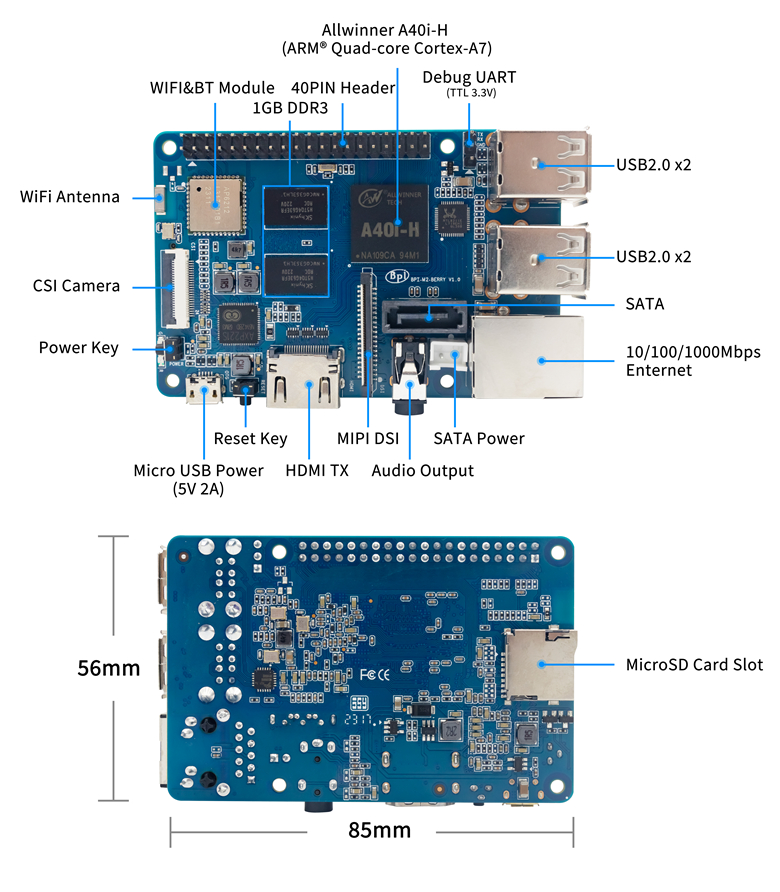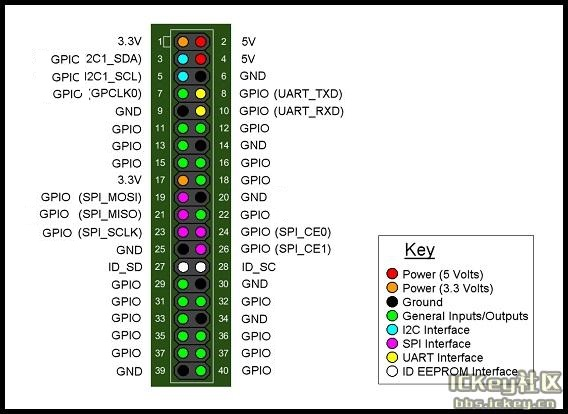Banana Pi BPI-M2 Berry
Contents
Introduction
Banana Pi BPI-M2 Berry is a quad-core mini single board computer built with Allwinner V40 SoC. It features 1GB of RAM . It also has onboard WiFi and BT. On the ports side, the BPI-M2 Ultra has 4 USB A 2.0 ports, 1 USB OTG port, 1 HDMI port, 1 audio jack, a DC power port, and last but not least, a SATA port..
Also being a member of the Banana Pi family, the M2 Berry is a direct upgrade from the Banana Pi M1/M1+ that support SATA from the SoC. The SATA performance on the V40 is fitting for media related projects such as storage servers. Backed by our community, starting a project and building servers is fun and rewarding. We welcome all companies, DIYers, and tech loving people within our community! Together, we can make a difference, we can discover our passions, inspire others, and build a practical project.
all size is same as raspberry pi 3,so you can use raspberry pi 3 case for BPI-M2 Berry.
Key Features
- Allwinner R40/V40 Quad Core ARM Cortex A7 CPU
- 1GB DDR3 SDRAM.
- WiFi (AP6212) & Bluetooth onboard.
- SATA Interface.
- 4*USB 2.0
Getting Start
Hardware
Hardware interfact
Hardware spec
| HardWare Specification of Banana pi BPI-M2 Berry | |||
| Soc | Allwinner R40/V40 | ||
| CPU | quad-core cortex -A7,the most power efficient CPU core ARM's ever development | ||
| GPU | dual-core MALI-400 MP2 and runs at 500MHz, capable of 1.1 Gpixel/s throughput. Graphics capabilities are slightly higher than the original Xbox’s level of performance. The GPU provides OpenGL ES 2.0, hardware-accelerated OpenVG, 1080p45 H.264 high-profile encode and decode. | ||
| SDRAM | 1GB DDR3 with 733MHz\(shared with GPU\) | ||
| SATA | suppoort SATA interface | ||
| GPIO | 40 Pins Header, 28×GPIO, some of which can be used for specific functions including UART, I2C, SPI, PWM, I2S. | ||
| On board Network | 10/100/1000Mbps Ethernet \(Realtek RTL8211E/D\) | ||
| Wifi Module | WiFi 802.11 b/g/n \(AP 6212 module on board\) | ||
| Bluetooth | BT4.0 | ||
| On board Storage | MicroSD \(TF\) card,No eMMC onboard | ||
| Display | 4-lane MIPI DSI display,or RGB panel or LVDS panel,TV-out on HDMI V1.4 | ||
| Video | Multi-format FHD video decoding, including Mpeg1/2, Mpeg4, H.263, H.264, etc H.264 decode up to 1080P60,support video encodeing:High-deinition\(HD\)H.264 video encoder is up to 1080P@45fps | ||
| Audio outputs | HDMI, analog audio \(via 3.5 mm TRRS jack\), I2S audio \(also potentially for audio input\) | ||
| Camera | A CSI input connector Camera:Supports 8-bit YUV422 CMOS sensor interface,Supports CCIR656 protocol for NTSC and PAL,Supports 5M pixel camera sensor ,Supports video capture solution up to 1080p@30fps | ||
| Audio input | On board microphone | ||
| USB | 4 USB 2.0 host, 1 USB 2.0 OTG | ||
| Buttons | Reset button, Power button, U-boot button | ||
| Leds | Power status Led and RJ45 Led | ||
| IR | No onboard IR receiver | ||
| DC Power | 5V/2A with micro USB port | ||
| battery | No 3.7V lithium battery power support | ||
| Sizes | 85mmX56mm,same size as raspberry pi 3 | ||
| Weight | 40g | ||
GPIO PIN define
Banana Pi BPI-M2 Berry has a 40-pin GPIO header that matches that of the Model Raspberry Pi 3. Following is the Banana Pi GPIO Pinout:
| 40 PIN GPIO of Banana pi BPI-R2 | ||||||||||||||||||||||||||||||||||||||||
| Default Function | Function2:GPIO | Function3 | | VCC-3V3 | | | DCIN | | | TWI2-SDA | PB21 | PWM5 | | DCIN | | | TWI2-SCK | PB20 | PWM4 | | GND | | | PB3 | PB3 | PWM1 | | UART2-TX | PI18 | SPI1\_MOSI | | GND | | | UART2-RX | PI19 | SPI1\_MISO | | UART7-TX | PI20 | PWM2 | | UART2-CTS | PI17 | SPI1\_CLK | | UART7-RX | PI21 | PWM3 | | GND | | | PH25 | PH25 | CSI1-FIELD | | UART2-RTS | PI16 | SPI1\_CS0 | | VCC-3V3 | | | PH26 | PH26 | CSI1-HSYNC | | SPI0\_MOSI | PC0 | | | GND | | | SPI0\_MISO | PC1 | | | PH27 | PH27 | CSI1-VSYNC | | SPI0\_CLK | PC2 | | | SPI0\_CS | PC23 | | | GND | | | PH24 | PH24 | CSI1-PCLK | | TWI3-SDA | PI1 | | | TWI3-SCK | PI0 | | | PH0 | PH0 | CSI1-D0 | | GND | | | PH1 | PH1 | CSI1-D1 | | PD20 | PD20 | CSI1-MCLK | | PH2 | PH2 | CSI1-D2 | | GND | | | PH3 | PH3 | CSI1-D3 | | UART5-RX | PH7 | CSI1-D7 | | UART4-TX | PH4 | CSI1-D4 | | UART5-TX | PH6 | CSI1-D6 | | GND | | | UART4-RX | PH5 | CSI1-D5 | | |

